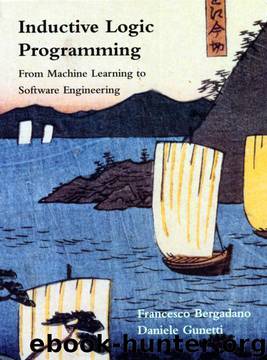Inductive Logic Programming: From Machine Learning to Software Engineering (Logic Programming) by Francesco Bergadano

Author:Francesco Bergadano
Language: eng
Format: epub
Published: 2011-08-22T23:40:00+00:00
instantiates to the following two clauses:
append(X,Y,Z) :- cons(X1,X2,X), no_op(X1,Y). append(X2,Y,W), cons(X1,W,Z).
where we may think of a given background knowledge including:
cons(X.Y.[XIY]).
Inenlber(X. [XIY] ).
n1eci1ber(X.[_ Y]) :- inc~iiilx'r(X,Y).
no-op(X,Y).
As we have seen. a rule model may be instantiated to clauses serving quite different purposes, depending on which actual predicates are used. In R.DT, the choice of the predicates is also constrained by a so-called topology, which is a kind of dependency graph appropriate for the application domain: the predicate in the consequent, of a clause is required to depend on the predicates in the antecedent. The details of this mechanism for limiting the possible instantiations of predicate variables are found in [107]. A similar notion of dependency is found in S. Russell's determinations [170].
The notion of rule model has recently been extended to more general clause templates by Tausend [1901. A main improvement over rule models consists in the fact that the arguments in a literal may also be abstracted into a variable. This will allow us to provide schemata for defining predicates of different arity. For instance, the following clause:
Download
This site does not store any files on its server. We only index and link to content provided by other sites. Please contact the content providers to delete copyright contents if any and email us, we'll remove relevant links or contents immediately.
Algorithms of the Intelligent Web by Haralambos Marmanis;Dmitry Babenko(16235)
Jquery UI in Action : Master the concepts Of Jquery UI: A Step By Step Approach by ANMOL GOYAL(9387)
Test-Driven Development with Java by Alan Mellor(7735)
Data Augmentation with Python by Duc Haba(7609)
Principles of Data Fabric by Sonia Mezzetta(7378)
Learn Blender Simulations the Right Way by Stephen Pearson(7294)
Microservices with Spring Boot 3 and Spring Cloud by Magnus Larsson(7137)
Hadoop in Practice by Alex Holmes(6587)
RPA Solution Architect's Handbook by Sachin Sahgal(6516)
The Infinite Retina by Robert Scoble Irena Cronin(6216)
Big Data Analysis with Python by Ivan Marin(5933)
Life 3.0: Being Human in the Age of Artificial Intelligence by Tegmark Max(5516)
Pretrain Vision and Large Language Models in Python by Emily Webber(4894)
Infrastructure as Code for Beginners by Russ McKendrick(4653)
Functional Programming in JavaScript by Mantyla Dan(4436)
WordPress Plugin Development Cookbook by Yannick Lefebvre(4382)
The Age of Surveillance Capitalism by Shoshana Zuboff(4245)
Embracing Microservices Design by Ovais Mehboob Ahmed Khan Nabil Siddiqui and Timothy Oleson(4148)
Applied Machine Learning for Healthcare and Life Sciences Using AWS by Ujjwal Ratan(4135)
